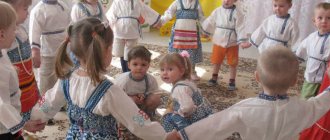Didactic games for speech therapy classes with preschoolers
Speech therapy educational games for preschoolers
Educational games Author: Tatyana Vasilievna Chervyakova, speech therapist, MDOU kindergarten “Rodnichok” Description: The presented didactic games will be useful for speech therapists and kindergarten teachers. The material is intended for conducting individual and subgroup speech therapy sessions with preschoolers.
Purpose of the game: to activate vocabulary on the topic “Vegetables” and “Fruits”; Teach children to divide words into syllables. Material: drawings: planar images of baskets with syllabic patterns, images of objects - vegetables and fruits. Progress of the game: Speech therapist. Guys, today we are going to visit our grandparents in the village to see what vegetables have grown in the beds. – And then our grandparents meet us.

Speech therapist. Grandma invites you to guess what vegetables they collected. – round, red, juicy, healthy, soft... (tomato) – oval, green, crunchy, rough, hard... (cucumber) – oblong, orange, hard, tasty, vitamin... (carrot) – round, bitter, hard, healthy ... (onion) - round, green, juicy, crispy... (cabbage)

Speech therapist. Guys, you guessed all the vegetables. Now let's put them in baskets. – Notice what beautiful baskets grandma prepared. Each basket has a syllabic pattern. Let's name the vegetables one by one, determine the number of syllables in each word and put the vegetable in the correct basket.
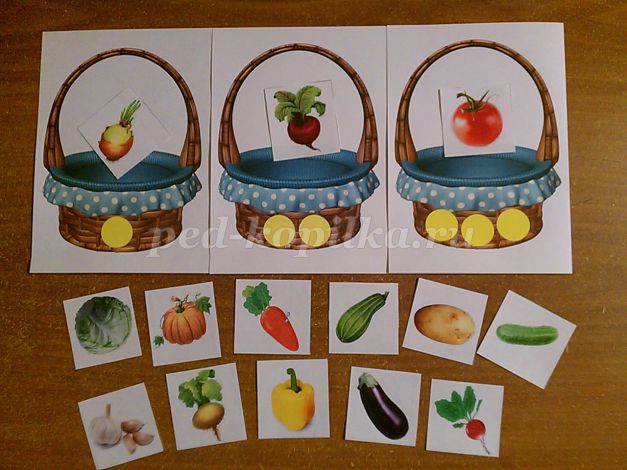
A similar game can be played on the theme “Fruits”. As material we use images of objects - fruits.

Didactic game “Syllable Houses” Purpose of the game: to teach children to break words into syllables. Material. Airplane images of houses with window pockets. Every house has a syllabic pattern. Images of objects depicting fairy tale characters: Wolf, Carlson, Dunno, Pinocchio, Malvina, Puss in Boots and others. Progress of the game. Speech therapist. The heroes of fairy tales came to visit us. Nominal. Child. Wolf, Carlson, Malvina, Pinocchio, Aibolit.
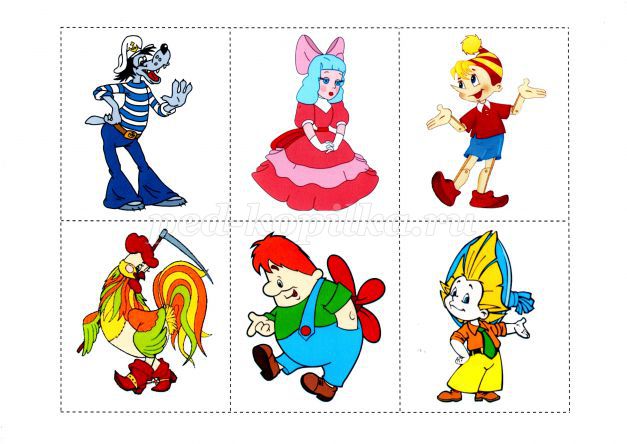
Speech therapist. Guests should be “settled” in houses. Determine the number of syllables in each word and “place” the hero in the desired house.
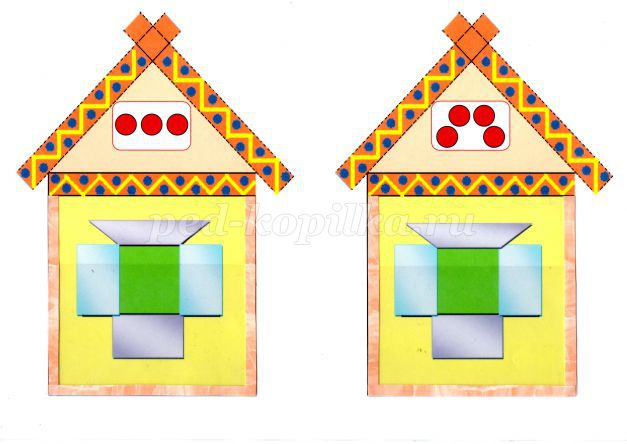
Child (speak and emphasize the syllables) - “Karl the Son” - two syllables (puts the photo in the pocket of house No. 2) - “Wolf” - 1 syllable (puts the picture in the pocket of house No. 1).
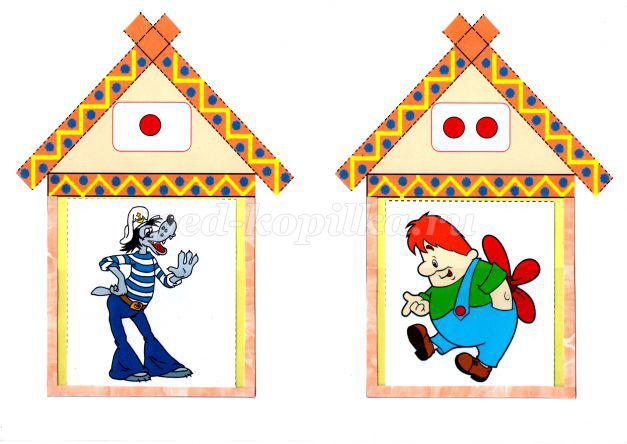
- “Mal-vi-na” - this word has three syllables (puts the picture in the pocket of house No. 3) - “Bu-ra-ti-no” - the word has four syllables (puts the picture in the pocket of house No. 4)
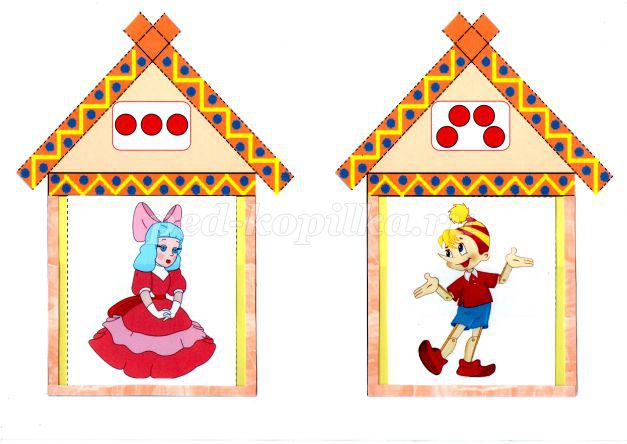
Speech therapist. Very good! The manual can be used when studying other lexical topics.
We recommend watching:
Speech therapy games for preschoolers Games for the prevention of optic dysgraphia and dyslexia in preschoolers Speech therapy games for kindergarten using animals Do-it-yourself speech therapy board games for kindergarten
Similar articles:
Speech therapy games for preschoolers and primary schoolchildren
DIY speech therapy games for preschoolers
DIY speech therapy games
Speech therapy game for older preschool children
Speech therapy game for children 5-8 years old “Who is faster”
The role and significance of speech therapy games
The process of further development of the child depends on how well the speech is formed. That is why it is so important to promptly prevent various defects and monitor the purity of the sounds produced by the baby. Violations are noted not only in the speech of a preschooler, but also in perception and production itself. When determining the degree of the defect, all symptoms associated with mental, physical and speech development are identified.
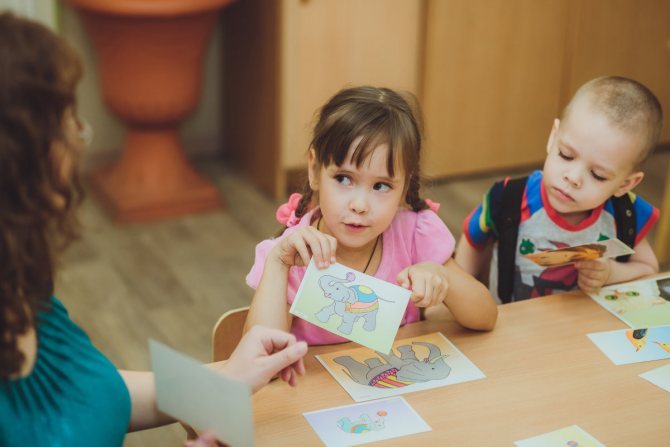
Language educational games
Note! Play is the main activity of a child; with its help, he masters various forms of thinking and develops his horizons. Speech therapy games play an important role in creating a favorable environment for a child to overcome speech disorders of varying severity.
Speech therapy educational games for preschoolers have great potential: with their help, the student works on correct pronunciation of words, learns their native language and learns the rules of grammar in a simple form. Difficulties overcome in this way in a playful way are less obvious and tangible for the child.
The main significance of speech therapy games is to increase the vocabulary and horizons of children, expand the boundaries of the child’s consciousness and introduce him to the world around him.
How games help a speech therapist
Every year the percentage of preschool children with speech pathologies of varying complexity and etiology increases. To correct standard speech disorders, you need to practice at least 2-3 times a week for 30 minutes. However, it is difficult to captivate children with a monotonous task; they quickly get tired and refuse to complete the exercises suggested by the teacher. To increase motivation for learning, speech therapists use game techniques in their classes, thanks to which the correction process ceases to be boring for the child.
What else to read: Card index of didactic games and exercises for kindergarten on sensory development of young children
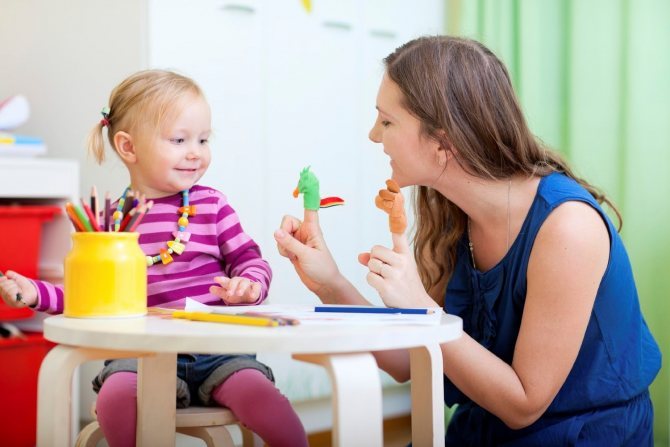
Speech therapist and child
Game aids and material for speech therapy sessions
Contained in sections:
- The work of a speech therapist. Speech therapy 8526
Includes sections:
- Differentiation, automation of sounds. Didactic games 394
- Breathing exercises. Homemade games and manuals 453
- Speech development. Speech games, teaching aids 3400
- Tongue. Speech therapy visual and didactic aids 15
By groups:
- Senior group
- Preparatory group
- Middle group
- Junior group
Showing publications 1-10 of 1454. All sections | Speech therapy games
New
Photo
The best
A collection of speech therapy games for the development of phonemic hearing and perception “Amazing stories of the mouse Shustrik”
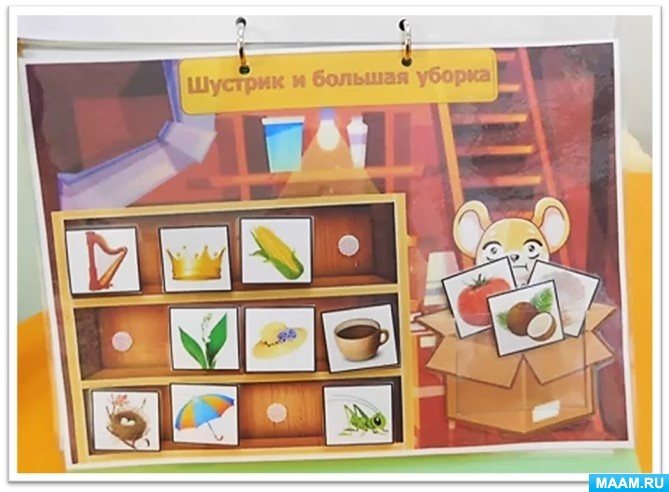
"The Amazing Stories of the Mouse Shustrik"
A collection of
speech therapy games for the development of phonemic hearing and perception Phonemic hearing is a subtle, systematized hearing that allows you to distinguish and recognize phonemes of your native language.
Phonemic hearing, being part of... The use of laptops in the work of a speech therapist teacher It is known that the timely acquisition of correct speech is of great importance for the formation of a child’s full personality, successful learning at school and further fulfilling life. Modern teachers, in connection with the implementation of the Federal State Educational Standard for preschool education, are looking for new approaches to...
Speech therapy games with a flashlight for children
Games with light are spectacular and exciting, and the flashlight is accessible and safe for children. The game was developed by teacher Natalya Konyakhina. For the game you will need sheets of paper from which the box will be made. You will also need drawings that can be printed on a printer or downloaded from the Internet (shoes, clothes, fruits, vegetables, animals and any other items studied in preschool). Items need to be cut out and glued inside the box so that the front side faces the baby. The child points a flashlight at the wall and answers the questions: “What do you see?”, “Whose shoes are these?”, “Is there an apple in the box or many?”
Underdevelopment of phonetic-phonemic speech in preschool children
Note! Games with a flashlight make it easy for a preschooler to develop coherent speech.
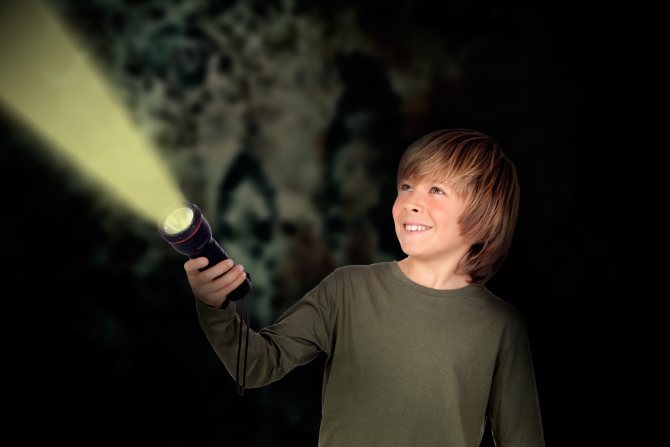
Child with a flashlight
Game “Make words”.
Target. Practice making three-letter words.
Equipment . Gymnastic hoops, two sets of numbers “1”, “2”, “3”.
Sets of letters (the first set: “K”, “O”, “T”, “D”, “Y”, “M”, from which the words “cat”, “smoke” are made; the second set of letters: “S”, “O”, “K”, “D”, “O”, “M”, from which the words “juice”, “house” are made; the third set of letters: “W”, “A”, “R”, “L” ", "U", "H", from which the words "ball", "ray" are made).
Carrying out the game. The teacher tells the children that today they will play words, each child will be a letter, and the letters have their own places in the hoops, where the number “one” will be the first letter, where “two” will be the second, where “three” - third. Then the children are divided into two teams. Two sets of three hoops are placed in front of them. The teacher puts the numbers “1”, “2”, “3” into each set. The teacher gives the children letters and says what words each team makes.
Children say a rhyme:
One-two, one-two,
We make up words.
Then each child must stand in their place and hold up their letter.
The team that completes the word first wins.
You can play the same game with more complex words.
Didactic games for the development of speech of preschoolers card index on speech therapy on the topic
Reminder for parents
“We talk, we play – we develop our discourse”
DEAR PARENTS!
Talk to the kids!
There is a lot of talk about how good language development is a prerequisite for academic success. However, parents do not always know how to develop this speech.
You can often hear: “We read a lot to the child, read poems, talked about everything, but there was no result; The child himself cannot describe the simplest image or tell anything.”
How could it be otherwise: after all, it was the parents who said it, not the child. Babies are all different - some are unstoppable, while others say nothing. But even the “silent” will speak if there is an incentive to speak out.
The performance begins with the desire to communicate!
No matter how imperfectly your child speaks, accept his desire and indulge him. Even if he doesn't speak at all, often engage him in nonverbal dialogue, welcoming and approving any response (gesture, expressive look). At the same time, try to give him the opportunity to listen to himself and himself. Especially create play situations where the child will need onomatopoeia or will have to say a few words for the game to take place. Keep in mind that it is not you who motivates, but the situation. Mood.
Try to pronounce a new word in an emotionally favorable situation: when the child is calm, in a good mood, in such conditions the child assimilates and assimilates information 10 times better than neutral or unfavorable information.
How can you develop speech?
1. Whether you are looking at an image, reading a book, draw your child’s attention to rare phrases, ask what this or that word means.
2. Play the game “Tell Me the Word”: an adult reads a short poem, and the child must guess and name the last word in it.
3. Play with words. This can make a long journey in transport, or the need to lie in bed, cheer up. These tasks include:
- what words, colors can describe the time of year, tell about the topic, what it is about (quote as many adjectives as possible);
- what he can do (name as many verbs as possible)
- play a bad and a good game. What is good about Baba Yaga and what is bad? What is good in the rain and what is bad?
- play opposite words (opposites)
4. Invite your child to tell a story, story, or cartoon. Ask what you liked and why. Ask to describe your favorite character.
5. Play the game: “Find the error in the sentence”
6. Teach your child to make a story from an image. Explain that a story has a beginning (as short as the morning), a center (as the day), and an end (as short as the evening).
7. Play a familiar fairy tale face-to-face with different intonations.
Remember! It's very easy to knock over a child. Treat your child with understanding.
Expand your child's vocabulary.
A child has words on two levels: he understands words - this is passive vocabulary, he speaks - he is active. The active vocabulary can be quite small. Try entering the names of things around it (toys, household items), the names of family and friends into the active dictionary. More often they ask: “Where is the table? Where's the clock? ”etc. This will certainly lead to an increase in vocabulary. Develop phonemic awareness (the ability to hear different speech sounds) by encouraging different sound words. (roof – mouse, nose – knife).
Read to your child.
Read short poems and fairy tales. Read them many times: don’t be afraid that your child will get tired of it. Children learn much better from texts they have already heard. If possible, try to quote the poem - show it with faces and objects; and let your child play with objects. Wait until the child has a good memory of the poem, get a feel for the rhythm, then try not to finish the last word of each line, allowing the child to do so. Sing simple songs to help him feel the rhythm and play it.
What else to read: Didactic game on traffic rules “Guess the sign” for children of senior preschool age
Fingers help the word.
Pay attention to the development of fine motor skills - precise finger movements. Modeling, drawing, finger theater, playing with small objects - all this will help speech, and in the future, writing. The child should work with naughty fingers as much as possible. No matter how boring it may seem, let the child button up his buttons, tie his shoelaces, and roll up his sleeves. It is also better to start training not with your own clothes, but first “help” the doll and even the parents get dressed. As a child's fingers become more dexterous, his speech will become more understandable to others. About the benefits of joint gymnastics in the development of a preschooler.
Joint gymnastics in the development of preschoolers.
Gymnastics for arms and legs is familiar to us. We train the muscles so that they become flexible, strong and agile. But why train? It turns out that the tongue is the main muscle of the speech organs. And like any muscle, it simply needs gymnastics. After all, the tongue must be well developed to make the subtle, intentional movements that produce speech sounds.
Pronunciation deficiencies aggravate the emotional and mental state of the child, preventing him from developing and communicating with peers. To prevent this problem from arising, you should start doing gymnastics for your joints now. With the help of articulatory gymnastics, existing violations of sound pronunciation are overcome.
At first, gymnastics should be done in front of a mirror. The child must see what his tongue is doing and where it is. In this case, the movements of the tongue are brought to automaticity by constant exercises. Work with your child every day for 5-7 minutes. Carrying out articulatory gymnastics in the form of a fairy tale (in a funny language) will help turn the exercises into an exciting game.
Believe in yourself!
Remember: only you and your faith in the child’s strengths and abilities can help him develop harmoniously. Be patient, kind and calm and you will succeed.
Development of fine motor skills to prepare the hand for writing.
It has now been shown that the development of fine motor skills of the fingers has a positive effect on the speech development of children. Employees of the Institute of Physiology and Adolescence of the Academy of Pedagogical Sciences of the Russian Federation determined that the projection of the hand to the brain is very close to the area of the speech motor. The relationship between the motor and speech zones is also manifested in the fact that a person who has difficulty finding a word helps himself with gestures, and vice versa: a child focused on drawing or writing involuntarily sticks out his tongue.
Therefore, training the movements of fingers and hands is the most important factor that stimulates the development of a child’s speech, helps improve articulatory movements, prepares the hand for writing, as well as a powerful tool that increases the performance of the cerebral cortex and, as a result, the level of development of thinking.
Activities that develop fine motor skills.
Have a beneficial effect on the development of hand and finger movements:
- massages and self-massage;
- finger gymnastics;
- visual activity;
- modeling;
- drawing;
- statement;
- handmade;
- manipulations with various objects: collecting pyramids, nesting dolls, builders, mosaics; unfastening and fastening buttons, Velcro, straps; lacing.
- shading, writing.
Games and exercises for children 2-4 years old.
Magic bag.
Examine toys and objects with your baby and touch them. Invite your child to touch one of the items in the bag, name it, and pick it up. Without removing the object, touch it, name it and describe it.
Tactile tables.
it is necessary to prepare a series of boards with different structural surfaces; with images of various objects cut out along the contour.
Tasks: with eyes closed, feel the outline and name the depicted object; find a specific image of an object with your eyes closed; find two identical cards.
Finger pool.
Tasks: lower your hands to the pool of fingers and touch the beans or peas; move to another container one by one; clench and unclench fists with beans and peas while holding hands in the pool; touch this object.
I turn and turn.
(Tasks with various massage balls, sticks, chestnuts, nuts, etc.)
Throw and grab an object with one hand, two hands, unfold an acorn or pine cone. Roll a massage ball or stick: with your palm, the edge of your palm, the finger of one palm towards the other, between your palms, on the back of your hand with rotational movements in one direction, in the other direction, vertically. Gradually increase pressure and rotation speed.
Rope.
Tasks: tie and untie knots; twine: remove the beads, twist the lace between the tips of the thumb and forefinger, wind the lace on a stick or thread on a spool, braid a pigtail, intertwine fingers with lace, decorate patterns and figures with lace.
Clothespins.
Tasks: use clothespins to hook a sheet of paper, the edge of a box or cup, or a rope; open and close the clothespin with your thumb and index finger, thumb and middle finger, etc. Ask your child to count the number of clothespins on the string, and only put clothespins of a certain color on the string.
What else to read: Didactic games for developing tactile sensations
Exercises with vocal accompaniment.
Fox.
Rhythmic opening and closing of a clothespin while pronouncing the text:
“Clever scammer, redhead. The mouth opens, it scares the rabbits.”
Crow.
Bend your hand towards the table and take the candy wrapper. Then the brush returns to its original position. Talk:
“I saw the paper and how to take it. I thought it was candy, but it turned out to be a candy wrapper.”
Dogs.
The exercises involve both hands, which rhythmically open and close clothespins while pronouncing the text:
“Two dogs bark, don’t bite. Two cubs walk around in the nest all day, screaming, opening their mouths to the crows, and really want to eat.”
For children 5-7 years old.
Finger gymnastics, games with letters and words. As a physical exercise, it is very good to use finger exercises with speech accompaniment. The dictionary has dozens of poems on every topic. For example:
The sky in Russia is blue
The rivers in Russia are blue – they bend like your finger.
There are maples and oaks, the fingers represent “branches”
What kind of mushrooms are there? The fist of one palm is covered with the other open palm.
Children love to speak in a secret language. Create your alphabet with your fingers. Use it to guess letters and then form words. [2]
Arrange the figures, counting sticks and matches.
Finger Theater. They develop attention, thinking, memory, stimulate the baby’s speech development, help relieve tension from the hands and lips, relieve mental fatigue, develop arms, become more mobile and flexible. Advise parents to take their children to a real theater to see various children's performances.
Written works, various types of shading, coloring of figures, pictures.
Currently, there is a large selection of literature on this topic. You can purchase it to your liking, but make sure the instructions are appropriate for your child's age and difficulty level.
A set of original speech therapy games “Chamomile Stories”
A set of original speech therapy games “Chamomile Stories” is intended for use in correctional and speech therapy work with children of senior preschool age and is compiled in accordance with the requirements of the federal state educational standard for preschool education, as well as taking into account the age and individual characteristics of preschoolers. A set of original speech therapy games “Chamomile Stories” is intended for use in correctional and speech therapy work with children of senior preschool age and is compiled in accordance with the requirements of the federal state educational standard for preschool education, as well as taking into account the age and individual characteristics of preschoolers.
The manual allows you to comprehensively solve problems in all educational areas: social and communicative development; cognitive development; speech development; artistic and aesthetic development; physical development. Allows you to intensify pedagogical activities aimed at timely and most effectively overcoming speech disorders in children.
Goal: Correction of speech disorders in older preschoolers through game material aimed at developing a respectful attitude and a sense of belonging to one’s family, instilling in children a sense of love and respect for their parents and their native land.
Objectives of the priority educational area “Speech development”
- enrichment of the active vocabulary;
- development of coherent, grammatically correct dialogical and monologue speech;
- development of the sound culture of speech, through the automation of sounds (S, Z, Sh, Zh, R, L), their differentiation, improvement of phonemic hearing;
- listening comprehension of texts from various genres of children's literature;
- formation of sound analytical-synthetic activity as a prerequisite for learning to read and write.
Educational objectives in the integration of educational areas:
"Social and communicative development"
- developing a respectful attitude and a sense of belonging to one’s family.
- introducing children to the customs and traditions of celebrating the holiday “Day of Family, Love and Fidelity”
"Cognitive Development"
- develop cognitive activity, curiosity, and creative thinking of children through familiarization with the history and traditions of the Orthodox holiday “Day of Family, Love and Fidelity”;
- formation of cognitive actions, formation of consciousness; development of imagination and creative activity;
"Physical development"
- improve fine motor skills
The form of organizing children's activities is speech therapy subgroup correctional and developmental games.
The set includes 6 speech therapy games:
- "Daisies for Natasha"
- "Gather the Family"
- "Speech therapy chamomile"
- "Who? Where?",
- "Pure talk"
- Illustrations for the text “Peter and Fevronia”.
"Daisies for Natasha"
Goal: automation of the sound [Ш] in words with different positions, improvement of phonemic hearing, enrichment of the active vocabulary, development of fine motor skills.
Equipment: one A4 playing field, 24 cards with daisies.
Vocabulary material:
- sound [Ш] at the beginning of a word: hat, shampoo, chocolate, fur coat, wardrobe, bumblebee, helmet, washer, box, jester, shorts, hat;
- sound [Ш] at the end of a word: shower, pencil, reed, lily of the valley, baby, mouse;
- sound [Ш] in the middle of a word: cat, frog, parsley, cone, horse, car.
Progress of the game
First option: The speech therapist invites the children to help the boy Misha collect a bouquet of daisies for Natasha. Children take daisies one by one and name the pictures drawn on them, clearly pronouncing the sound [Ш].
Second option: The speech therapist invites the children to help the boy Misha collect only those daisies for Natasha whose name contains the sound [Ш] at the beginning of the word (middle, end). Children take daisies one by one and name the pictures drawn on them, clearly pronouncing the sound [Ш], determine the place of the sound [Ш] in the word.
"Gather the Family"
Goal: automation of sounds [R, L] in words, differentiation of sounds [R - L], improvement of phonemic hearing, enrichment of active vocabulary, formation of a respectful attitude and a sense of belonging to one’s family, development of fine motor skills.
Equipment: one A4 playing field, 18 cards with boys and girls.
Vocabulary material:
- sound [R]: rainbow, daisy, fish, rose, rocket, hand, shell, dew, lynx;
- sound [L]: swallow, puddle, boat, spoon, horse, bow, lily of the valley, moon, bast shoes.
Progress of the game
The speech therapist offers children to help parents find their children. Preschoolers take turns taking cards with boys and girls, calling out the pictures on their costumes, clearly pronouncing the sounds [R - L]. They lay out the cards, correlating the sound in the word with the letter drawn on the tower.
"Speech therapy chamomile"
Goal: development of sound culture of speech, through the automation of sounds (S, Z, Sh, Zh, R, L), their differentiation, improvement of phonemic hearing; enrichment of active vocabulary, formation of cognitive actions, development of fine motor skills.
Equipment: 42 petals, each of which has pictures of objects whose names contain a sound. Six yellow circles with the letters: C,Z,SH,ZH,L,R
Progress of the game
Speech therapist:
Look from the window, There is a chamomile, a drop of sun. Collect petals - sound, try, name it!
A speech therapist distributes petals to playing children.
Children name the picture on their petal, determine whether the given sound is in the word and insert it into the corresponding core. After the daisies are collected, the speech therapist praises the children and asks them to repeat all the words in chorus: “Well done, but you still need to repeat the pictures together.”
Children name the pictures on each daisy, clearly pronouncing the sounds.
Vocabulary material:
- sound [R]: rainbow, fish, rose, rocket, shell, dew;
- sound [L]: swallow, puddle, boat, lily of the valley, moon, palms.
- sound [Ш]: hat, chocolate, chaise longue, shorts, box, flip flops.
- sound [Zh]: beetle, giraffe, acorns, jasmine, toad, vest.
- sound [S]: catfish, juice, sandals, salad, airplane, gardener.
- sound [Z]: hare, umbrella, sunset, castle, tan, tooth.
"Who? Where?"
Goal: development of coherent, grammatically correct dialogical speech; developing the ability to correctly use prepositions, enriching an active vocabulary, developing a respectful attitude and a sense of belonging to one’s family, and developing fine motor skills.
Equipment: one A4 playing field
Vocabulary material : grandfather, grandmother, father, mother, daughter.
Progress of the game
The speech therapist asks the children to name those who are drawn in the picture.
First option: The speech therapist asks the children questions, and preschoolers must answer with a detailed answer.
Who's sitting on the bed?
Who is behind the chair?
Who's at the table?
Who is sitting on the chair?
Who stands between the chair and the bed?
Who is standing in front of the stove?
Second option: The speech therapist asks the children to name where grandfather, grandmother, mother, father, daughter, cat are located.
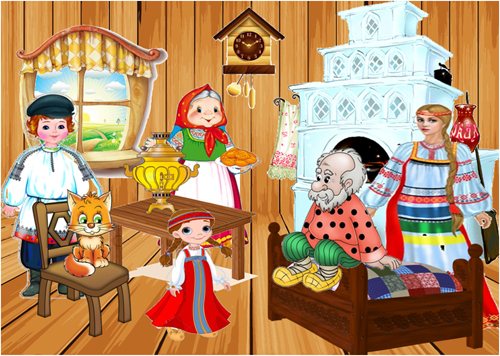
"Pure talk"
Goal: teaching children to clearly pronounce the given sounds [Ш, С, З, Р, Л] in phrasal speech, at a fast pace.
Equipment: 16 cards with pure sayings and illustrations for them.
A clean talker is a funny short poem, the purpose of which is the deliberate selection of words that are difficult for correct articulation when repeated quickly and repeatedly. Pure speech is also used as a means to correct speech defects in children.
Options for using pure phrases:
- pronouncing pure phrases in turn or in chorus, collectively;
- pronouncing pure phrases with different emotional tones of the voice;
- pronouncing pure sayings on behalf of fairy-tale characters (Karabas Barabas, Pinocchio, etc.);
- pronouncing pure sayings using the ball (simultaneously hitting the floor);
- pronouncing simple sayings using a massage ball.
Illustrations for the text “Peter and Fevronia”
Goal: enrichment of the active vocabulary; development of coherent, grammatically correct dialogical and monologue speech; developing the ability to understand texts from various genres of children's literature by ear; introducing children to the customs and traditions of celebrating the holiday “Day of Family, Love and Fidelity”; develop cognitive activity, curiosity, and creative thinking of children through familiarization with the history and traditions of the Orthodox holiday “Day of Family, Love and Fidelity”; formation of cognitive actions, formation of consciousness; development of imagination and creative activity.
Equipment: 5 A4 illustrations for the text “Peter and Fevronia”.
Progress of the game
The speech therapist invites the children to listen to the story and try to remember it.
In the glorious city of Murom lived and lived Prince Pavel. And he had a brother, his name was Peter. Pavel was in trouble. A snake began to fly to his wife. She complained to her husband, and Paul asked her to find out from the serpent the secret of his death. And the snake said that he was destined to die “from Peter’s shoulder and from his sword.” And Peter decided to help his brother - to destroy the damned serpent. He swung his sword and struck the adversary. But the serpent splashed Peter with its poisonous blood, and Peter’s body was covered with sores. No one could heal Peter from a serious illness. Peter humbled himself and prepared to die. But the Lord advised him: they say, there is a young girl in the Ryazan lands who can heal him.
The prince's servants found a girl named Fevronia. And she said that she could heal the prince, and did not ask for anything as a reward, but after his recovery, the prince must take her as his wife, otherwise the treatment would not work. The prince agreed. And after his healing he took Fevronia as his wife.
They lived happily ever after in love and harmony. And they died on the same day and hour. The holy spouses were buried together near the cathedral church of the Nativity of the Blessed Virgin Mary, and every believer received generous healing here.
So says the legend.
After reading, asks questions:
- In what city did Paul reign?
- What was his brother's name?
- Who flew to Pavel's wife?
- With what help did Peter deal with the serpent?
- What happened to Peter?
- How was Peter healed?
- What was the name of the girl who healed Peter?
After this, he gives the task to arrange the illustrations for the text in order. And then asks to retell the text based on them.
How to conduct classes at home
For many children, homework is much more fun than with a specialist. The child sees his mother or any other person he knows and feels safe. To get the most out of your lessons, you can purchase special guides that not only explain in detail how to set up and automate each sound, but also record the results. An example is N.V.’s speech therapy notebook. Sokolova.
Methods for correcting general speech underdevelopment in preschool children
For your information! Initially, speech therapy games should be accompanied by a voice explanation from an adult. After this, only the child should speak (or try to speak.
Speech therapy games for setting the sounds Ш and Ж
These sounds require a flattened position of the tongue, with the tip pressed against the upper palate. This can be achieved using the following exercises:
- "Shoulder". Stick out your wide tongue and place it on your lower lip.
- "Brush". Run the tip of your tongue from your teeth to your throat and vice versa.
- "Delicious jam." He licks his upper lip as if licking sweetness.
Speech therapy games for setting the sounds L and R
Both sounds require tension of the tip of the tongue against the roof of the mouth. However, the exercises for setting up sounds will be different.
Setting the “L” sound:
- "Punish your tongue." Extend and spread your tongue over your lower lip and lightly bite it with your upper teeth, making a “roo” sound.
- Alternating “spatula” and “back”. The tongue is spread over the lower lip or tense and is in the middle of the half-open mouth.
- "Horse". The purpose of this exercise is to teach the child to click by pressing the tongue against the alveoli behind the upper teeth.
Setting the "R" sound:
- "Car". Open your mouth wide, press your tongue against the upper tubercles and quickly say “ttt”, simulating automatic fire.
- "Brush your teeth". Run your tongue behind your upper teeth to the right and left.
- "Swing for children." Open your mouth and place the tip of your tongue directly on your upper lip, then on your lower lip.
Speech therapy games for setting the sounds Z, S and C
Normally, a child pronounces whistles correctly at 4 years of age. Exercises to help reproduce these sounds:
- Alternating a smile with the “Tube” exercise. Smile widely, hold this position for a few seconds, then purse your lips.
- "Pendulum". Open your mouth and point the tight tip of your tongue from the right to the left corner.
- "Slide". Place the tip of your tongue on your lower teeth and lift the middle palate above the upper palate, forming a cusp.
Important! When explaining the exercise, be sure to have a tabletop mirror with you, in which the child will see his reflection.
Each exercise must be repeated six times, the total execution time should not exceed 2-3 minutes. When trying to correct the situation, do not put a dirty hand in your baby’s mouth. If it is not possible to purchase special tools for a speech therapist (spatula), in case of forced contact with the child’s oral cavity, you can use a teaspoon, first sterilized in hot water.

Mirror in speech therapy games



